Ventilated facades of houses: device and installation
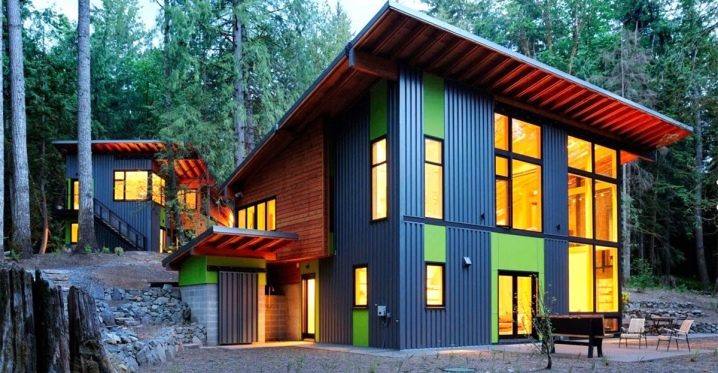
The exterior decoration of a house or building goes to a newer and higher quality level every year. Today, owners of private houses and buildings are increasingly using ventilated facades for cladding their homes. This is a beautiful and practical way to decorate your home that almost anyone can handle.

Features and purpose
If we turn to the definition of a ventilated facade, then it is characterized as a whole system consisting of several components.
- Metal carcass. It is attached directly to the load-bearing walls in such a way that an air pocket remains between the facing plates and the insulation layer. For this reason, this type of construction is called ventilated.
- Insulation layer... As a rule, mineral wool is used. Masters advise not to use polystyrene or expanded polystyrene as insulation, since they have a low level of noise absorption and vapor barrier.
- Cladding boards or blocks... They can be made of porcelain stoneware, fiber cement and other materials.
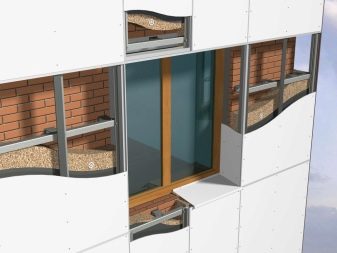
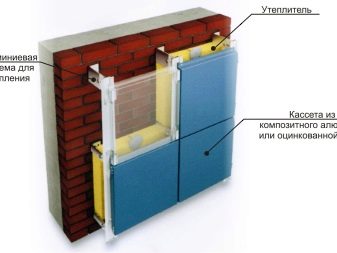
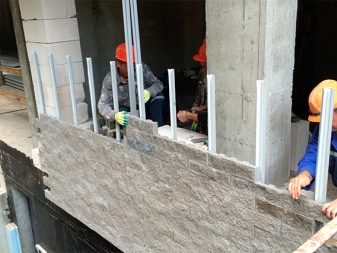
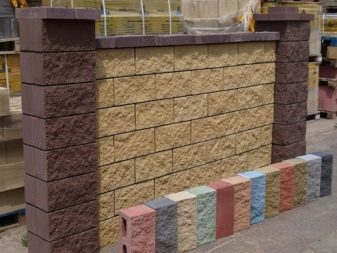
Ventilated facades are widely used in Russia due to a number of distinctive and unique properties. This technology was borrowed from Western colleagues and is widely used in our country with success. They are installed both on ordinary private houses and as external cladding of buildings, for example, supermarkets, shopping centers. Their merits are difficult to gloss over.
Its protective properties should be highlighted. As a rule, the ventilation facade is made of durable hydrophobic materials that perfectly protect the walls and the building itself from moisture and temperature changes. If some part of the water vapor has leaked between the slots, then it is absorbed by a thick layer of drainage. Hanging cladding is at least 25-30 years old. The service life depends on the selected material. If porcelain stoneware is used, then the guaranteed service life is at least 50 years.
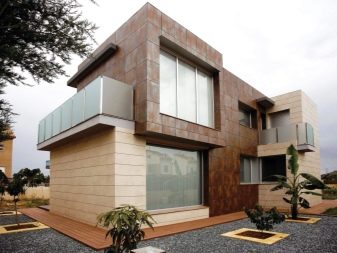
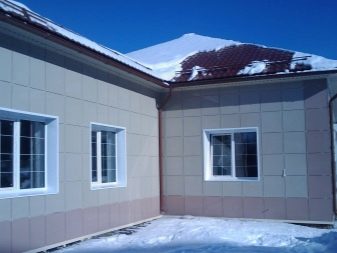
This system has a number of distinctive features in terms of its thermal insulation qualities. Such a facade does not allow the walls to heat up, and as a result, the interior does not overheat. The room is always comfortable: moderately warm and not hot. Due to its ease of installation, external cosmetic repairs can be done very quickly. And a wide variety of materials gives an unlimited number of options for creating a unique building design.
It is impossible not to mention its soundproofing properties. Due to the air gap, such a facade is able to contain a fairly high level of noise. In combination with triple or double glazing, such walls will provide the optimal level of silence in a noisy city. The materials that are included in the system of hinged ventilated facades are fire resistant and do not allow fire to spread.
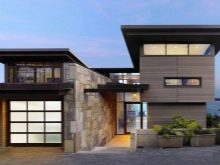
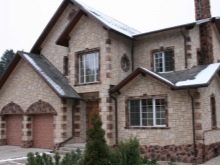
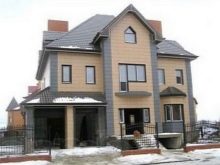
Design: pros and cons
Over the past few years, the number of projects for residential buildings, public organizations, educational institutions with the installation of a ventilated facade has increased tenfold. Like other cladding structures, the ventilation facade has a number of advantages and disadvantages, which must be taken into account during its installation and further operation.
There are few disadvantages to this facade structure, but they do exist.First of all, experts note that the system of frame metal assemblies for fastening can degrade the uniformity of the thermal air barrier. The metal does not keep heat, so it is necessary to lay a thicker layer of insulation. This is especially important for the northern regions of the country.
With an illiterate calculation of the thermal coefficient of materials, thermal insulation will be poor. For this reason, a number of problems may appear that require another cash injection. If we talk about insulation, then there are also a number of nuances. Over the course of long-term use, it undergoes a number of changes: shrinkage and thinning.
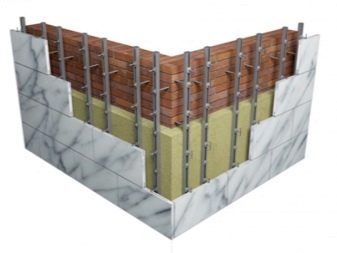
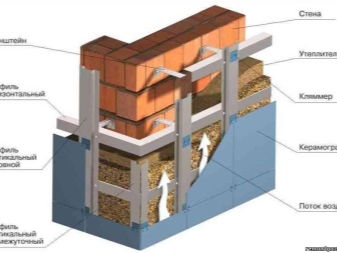
In order for this structure to perform well its functions, the masters advise to lay the insulation material like a "cake". The first layer consists of a softer and looser insulation, and the next one is more rigid and dense.
Ventilated façade design implies the presence of a small air gap and narrow slots. During rain or an active spring thaw, moisture easily gets into the air pockets. This leads to swelling and weighting of the mineral wool, as well as the appearance of mold in the house or apartment. To prevent such consequences, it is necessary to lay a special waterproofing film for vapor barrier. The financial side of the issue is also important. Installing a ventilated facade is slightly more expensive than fixing conventional siding panels. This price is obtained due to the large amount of calculations and the material used.
If we talk about the pros, then it is worth starting with the versatility of ventilated facades. Due to its ease of installation, it can be used on buildings and structures of any type. This structure is installed much faster than conventional cladding, since it does not require the initial preparation of the walls for installation.
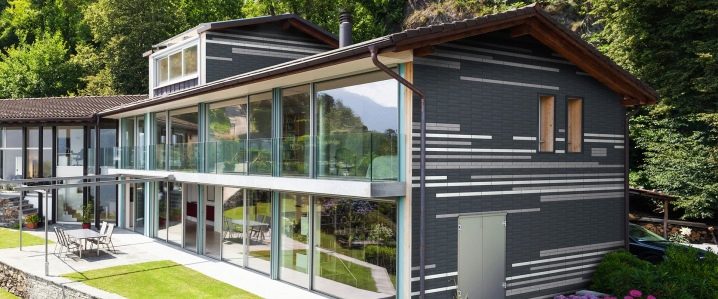
If any facing plate is deformed (chipped or broken off), then it is easy and simple to change. It is not necessary to remove all panels from the row.
Ventfacade is an excellent weather shield for a building. Due to the unique ventilation system, air flows do not allow water vapor to accumulate, "blow out" excess heat on a hot day, and also retain the internal heat of the building due to the air pocket. This facade can pay off in 10-15 years of use, subject to high-quality installation in accordance with all the rules and regulations. The building owner will spend much less money to keep the building warm.
In a private house with its own heating, much less gas or other fuel will be required to maintain a comfortable temperature in the rooms. No additional funds are required to maintain the veneer. If we compare the number of positive and negative aspects of the ventilation facade, then we can say with confidence that it is excellent for the climatic conditions of Russia and will adequately serve its entire guaranteed operational life.
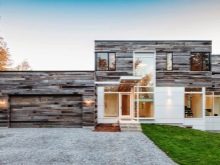
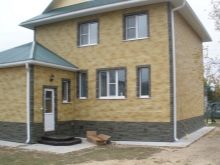
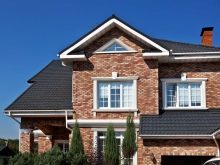
Basic elements: types and properties
The ventilated façade has a clear structure that consists of a number of elements. It is very important that the installer is able to work with all kinds of materials and know their physical properties. Otherwise, an inexperienced employee can make a large number of gross mistakes that can significantly affect the final result. The first and most basic element is the retaining wall. Its technical parameters determine the choice of the design, which will be installed in the future.
- Deviation of walls vertically and horizontally from a straight axis... Very often you have to work with a building where the foundation is skewed or the walls have an uneven structure. In this regard, it is necessary to select a special fastening system that will not increase the load on the structure.
- Material used for the construction of the facility... Today, houses and buildings are built from various building materials: brick, wood, foam blocks and others.They have a different composition and certain technical parameters that must be taken into account when installing a ventilated facade.
- Degree of wear load-bearing walls and structures.
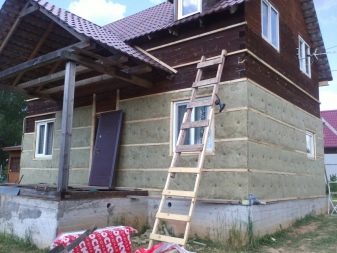
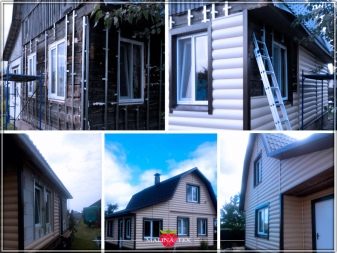
If you want to improve the facade of a building that is built from old and crumbling bricks, then you need to use lightweight and at the same time durable materials. They will "hold" the walls and prevent them from collapsing further.
The second element of the ventilation facade is a substructure or subsystem. These include the following elements:
- brackets;
- bearing profile;
- auxiliary materials (fastening angles, anchors, dowels, screws and others).
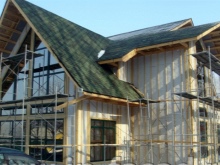
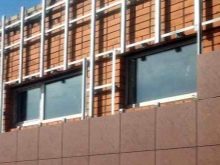
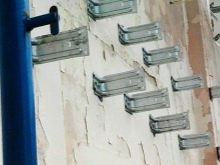
With the help of these elements, a strong lattice is created, on which insulation and cladding material are subsequently attached. Thanks to her, the very necessary air space or ventilation pockets is created. And also no glue solution is required to fix the facade boards, and this is a significant cost saving. Today there is a production of both wood and metal planks. The choice of material depends on the building, insulation and facing slabs.
The next layer is heat insulating. It includes a layer of insulation that performs the following functions:
- protects walls from freezing, the formation of an ice crust, frost;
- does not allow moisture to destroy the structure of the house from the inside;
- keeps the heat inside the building;
- provides additional sound insulation in the room.


It is best to take mineral wool as a heater - it is a non-combustible material. It does not absorb moisture, is easy to use and does its job perfectly. In colder regions, a paronite gasket is very often laid in front of a layer of insulating material, which performs a thermal break function. Additional insulation helps to avoid the appearance of so-called cold bridges.
The fourth element in the ventilated façade system is the windproof membrane. It is necessary in order to hold back moisture and prevent it from penetrating into further layers.
On the market you can find insulation that already has a layer of this film, but it is better to buy it separately (the gaps between the plates should also be "covered").
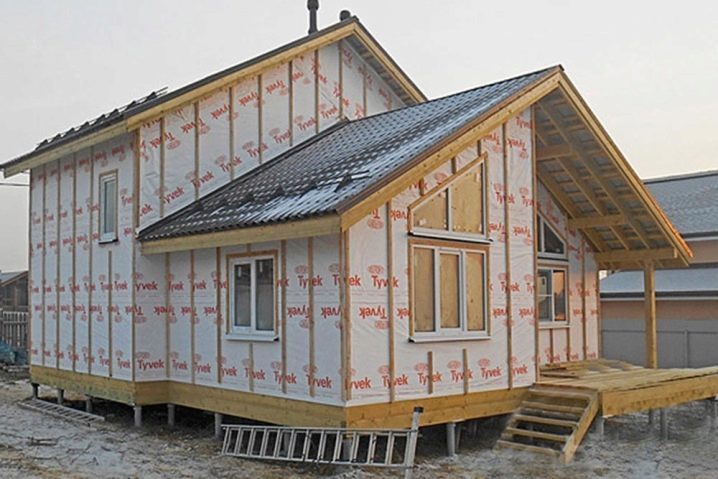
The next link in this design is the air gap. Here he plays a key role, because thanks to him, a traction effect is created. Air flows evenly circulate under the facing material and prevent moisture from settling on the surface of the insulation and the protective film. And he also participates in heat exchange between the environment and the building itself. Thanks to the clearance, the heat loss in winter is significantly lower.

The final element of the system is the cladding boards. They can be made of various materials: sandstone, porcelain stoneware, marble and others. Facade panels are selected for the type of building, the condition of its walls (degree of dilapidation) and other aesthetic preferences (color, shape, structure). The cladding has the following functions:
- protects the building from external influences: temperature drops, rain, snow and others;
- hides insulation and other communications, if any;
- improves the appearance of the building, as well as gives it a modern and beautiful look.
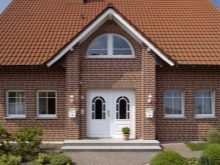
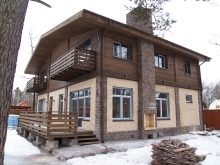
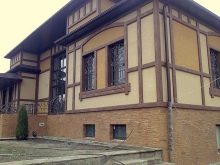
Air gap
One of the important aspects of a ventilated facade is the air gap. First of all, you need to understand its main functions, such as:
- it helps to equalize the pressure exerted on the facade of the building during strong hurricanes or sharp gusts of wind;
- an air pocket helps to trap heat inside the building;
- the ventilation gap does not allow rain drops to penetrate inside. The walls of the building are always dry;
- thanks to its "capillary" system, the facade is blown out. In this regard, water vapor does not linger inside, as a result of which the risk of mold and mildew is reduced;
- the air gap helps to hide all the roughness and unevenness of the surface of the walls. Such a facade is especially relevant for old buildings.
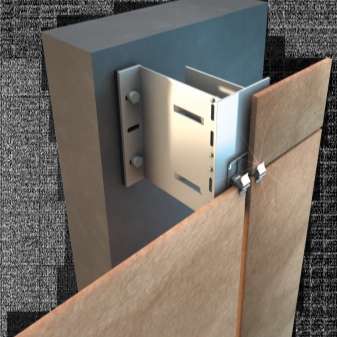
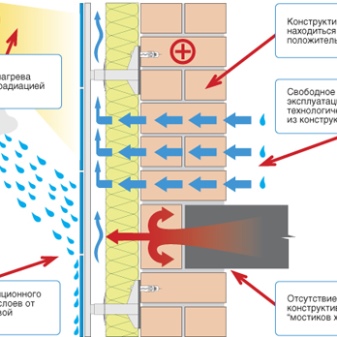
There are a number of normative documents that indicate the minimum value of the ventilation gap. The air gap between the insulation and the cladding panels should be at least 2–2.5 cm. The distance may decrease or increase depending on the evenness of the wall or the climatic characteristics of the region. The main thing is that it is enough for the normal functioning of the drainage layer. There are also very long distances - 10-13 cm.
Masters advise that the gap does not exceed 15 cm, since it will not fulfill its main function - thermal insulation.
The calculation is done based on parameters such as:
- the area of one sheet or slab of the facade coating;
- its thickness.
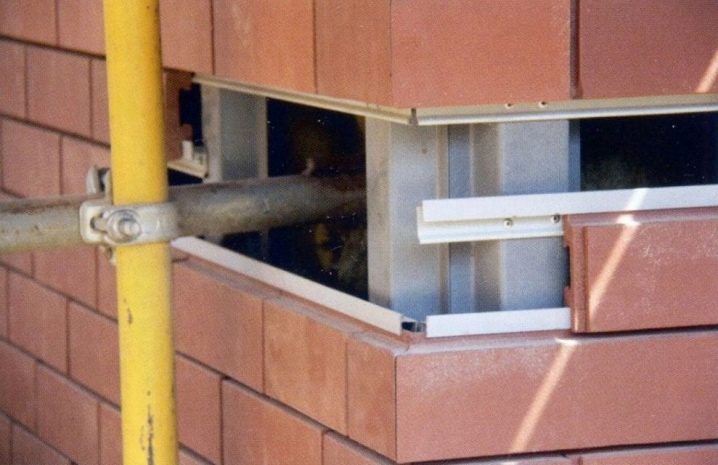
If there are open seams on each side of the panel, then the gap should be - 5 cm, provided that the facing material is 0.2–1 cm wide and the surface area of an individual slab is 0.3–0.4 square meters. m, and with a smaller area - 3 cm. In the case of only horizontal or vertical open joints, the distance of the air gap should be 4 cm, when the width is also 0.2–1 cm and the surface area of one panel is 0.3–0.4 sq. m.With a smaller area, the ventilation gap should be 2 cm.
An important point when calculating the distance between the cladding and the insulation is fire safety. From the school physics course, everyone remembers that fire burns only where there is oxygen. Since there is an air flow between the facade slabs, which can create a traction effect like in a Russian stove, it can create a situation that contributes to the spread of fire through the building. Therefore, the larger the width of the air pocket, the greater the risk to the structure during a fire. In this regard, it is required to install a special barrier that will restrain air flows and prevent the spread of flame. If the gap is small (2-3 cm), then it is not required.
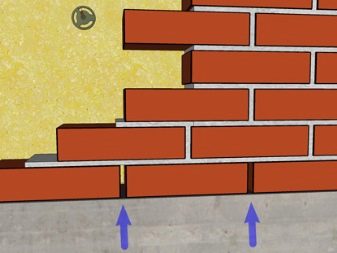
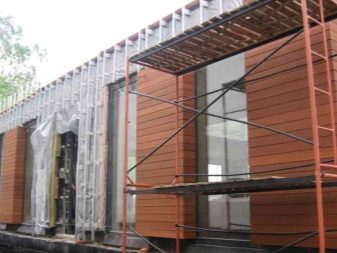
Varieties of systems
Today the market is overflowing with a variety of materials for installing a ventilated facade. They vary in both price and quality. In this regard, three groups are conventionally distinguished, which differ in pricing policy. This is just a basic list of systems used on ventilated facades. Every year, more and more perfect and versatile facing boards or panels appear, which can please with their appearance, excellent physical properties and a pleasant price.
- A budget option. It uses inexpensive materials. The metal frame is made of aluminum or zinc profiles. Glass wool or slag wool is taken as a heater. The cladding is also simple. This can be faux stone tiles, wood paneling, vinyl or aluminum siding.
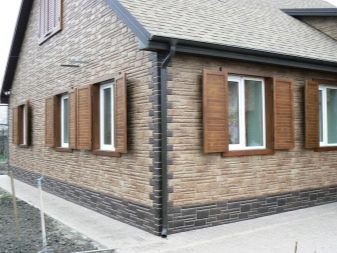
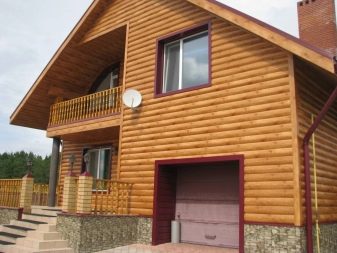
- Mid-price option. As a rule, goods with an average price are selected here, or some materials are more expensive, and some are cheaper. For example, the frame can be made of galvanized steel, insulation is chosen with an average price, and as cladding - a profiled sheet or metal profile. Or, on the contrary, they save on a frame with insulation and acquire a higher-quality facade tile made of composite materials.

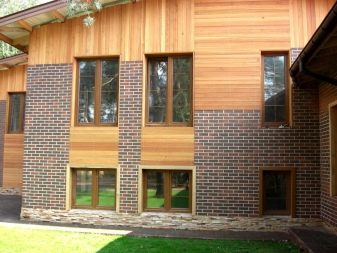
- An expensive option. Here, high quality materials are selected to maximize the life of the ventilation facade. If, for example, this is a private cottage and the owner wants to do external redecorating as little as possible, then preference will be given to a steel frame with anti-corrosion spraying, high-quality insulation - mineral wool, penoplex, and composite tiles (they are especially resistant to aggressive external environment).
It is worth understanding the fact that the choice of components should be based on the material from which the walls are built. If it is aerated concrete, then all selected materials should be lightweight. For a monolithic or brick house, almost any design is suitable.
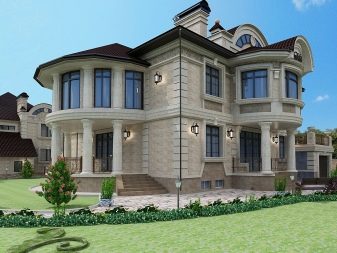
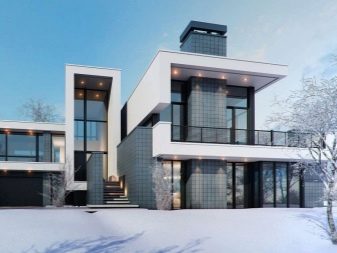
Craftsmen classify ventilated facades according to the type of facade slabs used.
- Fiber cement cladding. This is one of the most commonly used types of cladding. It is composed of cement, fiberglass, cellulose, and plastic. Plates have a long service life and are an excellent additional heat insulator due to their dense structure. They have a beautiful texture as well as a large color palette. They are an environmentally friendly product, do not emit toxic substances into the atmosphere when heated. Another positive feature of this cladding is the adjustable weight. Manufacturers can make lighter and thinner slabs for dilapidated buildings to reduce stress on load-bearing walls and foundations. There are few significant disadvantages - the ability to absorb moisture, and as a result, increase the weight by 4–6% of the total mass.
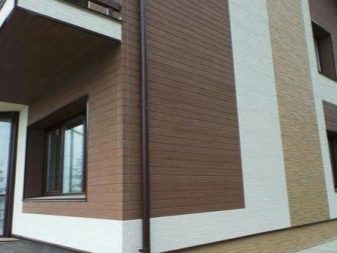
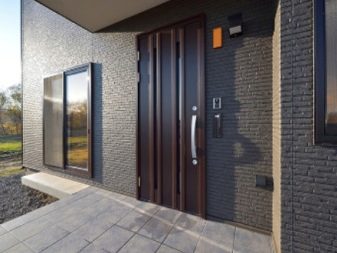
- Facing imitation of natural stone or brick... This option is practical and always in fashion. This facade material will last a long time. It is made from a mixture of cement, gypsum and stone chips. It does not absorb moisture, is lightweight and comes in a variety of colors.
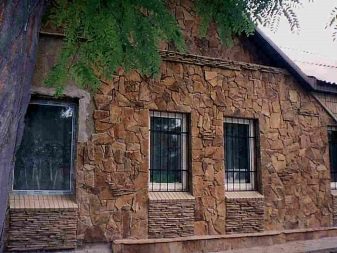
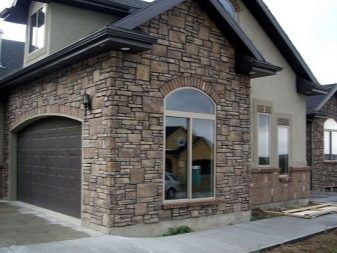
- Aluminum Composite Panels... It should be noted right away that this is a multi-layer facing material, which consists of several layers of aluminum, cellulose or plastic. The negative qualities include the high price and the ability to scratch the paint layer. There are many advantages of such facade slabs, namely:
- have excellent sound and heat insulation properties;
- do not corrode;
- not susceptible to ultraviolet rays, food acids and alkaline solutions;
- excellent ratio of weight and strength, the boards are very strong and rigid in structure;
- do not absorb moisture;
- do not burn.
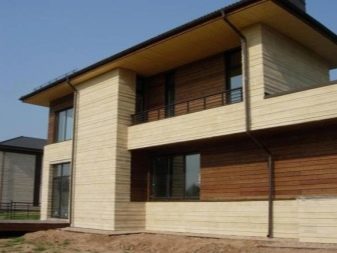
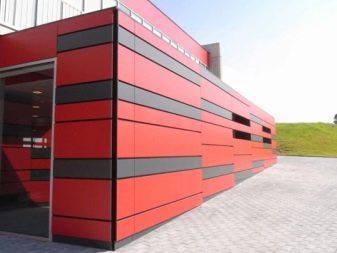
- Algomerate slabs. It is one of the most durable cladding materials. It contains only natural ingredients: granite and marble chips. By its structure, it is a very durable and reliable material, therefore the tile does not lend itself to the effects of atmospheric phenomena in the form of rain, hail, snow, strong wind. If we talk about the texture, then it can be rough and smooth. The color palette is very diverse and will delight the buyer with a large selection.
This cladding has a lot of weight, so the craftsmen recommend fixing such plates only on a steel frame.
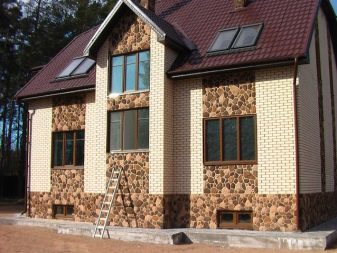

- Glass front panels. This type is most often found in large business centers or shopping malls. They add a special charm and beauty, making the building ultramodern, fashionable and airy. This type of cladding has both positive and negative sides. The advantages include the spectacular facade, reliability and strength and low weight. The disadvantages of glass facade panels include, such as:
- condensation forms during the cold period;
- the need for monthly cleaning, otherwise there will be stains on the surface from rain drops or other precipitation;
- if the slabs are poorly fixed or the building collapses, then they can break and form glass chips, which are very traumatic
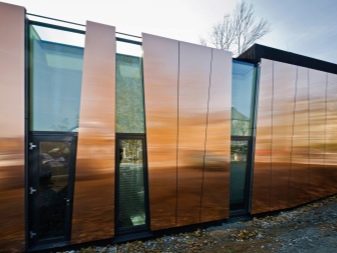
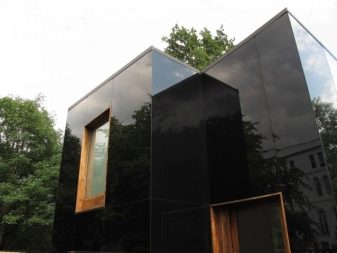
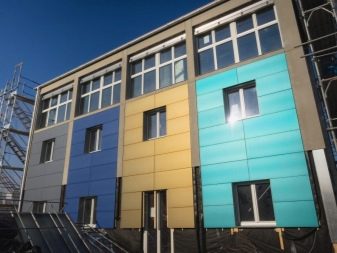

- Natural wood panels... Wood cladding has been on the market for a long time and is appreciated for its unique qualities. First of all, it is an environmentally friendly material that does not harm humans. These panels "breathe" and have excellent thermal insulation properties. Wood paneling makes a building or house more comfortable and pleasant to look at.
The only drawback of such a facade is that it must often be treated against insect pests, covered with a protective solution against mold and mildew.
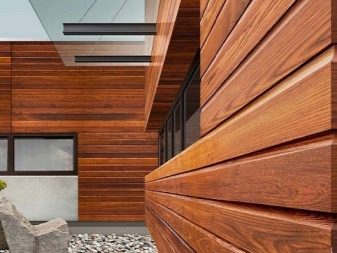

Manufacturers and innovations
The ventilated façade is a relatively recently adopted building cladding technology. She has already managed to establish herself in the market and receive positive feedback from consumers.Today, there are more than 150 companies in Russia that are engaged in the production of the necessary component materials (fasteners, facing tiles, insulation and others), its calculation for buildings with subsequent installation.
If we talk about individual firms, then one of the most famous is White Hills. This company is engaged in the production of stone cladding panels using vibration casting technology. They have established themselves as a supplier and manufacturer of quality products that will help to implement any design idea. And also they have a unique system of fastening facade slabs. Thanks to it, moisture is not retained in air pockets, and the air is constantly circulating.
White Hills guarantees its products will last at least 40 years. Ventilated facades from White Hills are also appreciated abroad.
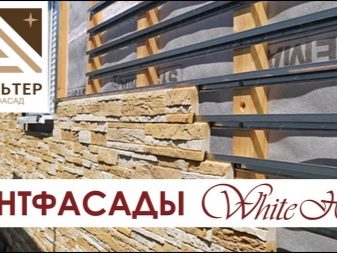
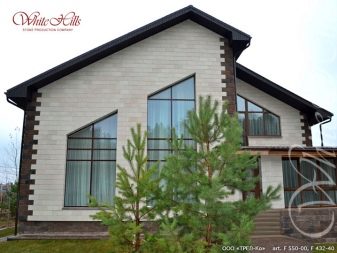
Alucobond, a company from Switzerland, is not inferior in quality. Their product is metal multicomponent sandwich panels, also called alucobond. It is a durable building material that can last at least 40-50 years without repair or any other intervention. Due to their plastic properties, such panels are easy to cut and "fit" to the shape of the wall. They are very durable, do not corrode, do not react to food acids and alkaline solutions.
The design of this facing material has a lot of options. The panels have a wide range of colors and can also imitate various surfaces (marble, wood, chrome and others). Consumers note that they are easily and quickly attached and do not create additional stress on the foundation and load-bearing walls. The disadvantages of Alucobond include the following:
- the material emits toxic substances when burning;
- in case of replacement it is necessary to remove a number of additional panels.
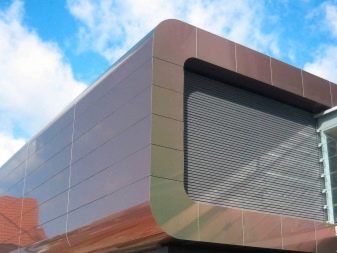
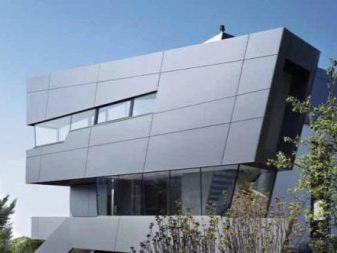
Products of the Nord Fox company are highly appreciated. It produces all the necessary components for the installation of a ventilated facade, as well as high quality cladding panels. They are installed both in private buildings and in multi-storey business centers. The façade-stroy products are distinguished by the beauty and aesthetics of facade tiles. She is appreciated for a large selection of textures and textures of the material, as well as an affordable price.
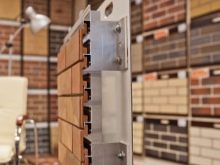
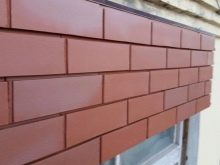
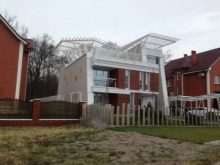
I am pleased with the products of Scanroc. It provides a wide range of materials at an attractive price. Japan is one of the most technically advanced countries. Japanese companies also excelled in the production of facade panels. Japanese tiles are solar panels that store solar energy and convert it into electricity.
This type of facade is very expensive, but it pays off in about 5-6 years of use.
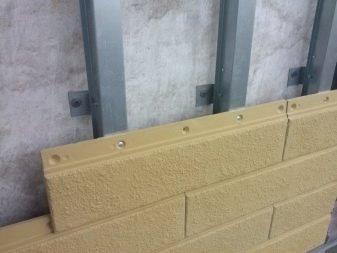
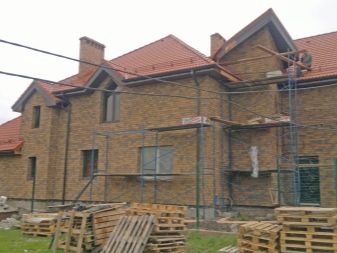
Rules for calculating materials
According to the rules and norms of construction and finishing works, all calculations of component materials are performed even at the design stage of a private building or house. But in practice it turns out a little differently. It so happens that the owner wants to improve the external and internal state of the building by installing a ventilated facade, where a preliminary calculation of the necessary elements is also required.
You can make both an independent calculation and contact specialists if you have little experience in this matter. The second option is simpler and better, since a person will receive accurate data: the number of fastening structures, the thickness and density of the insulation (it all depends on the humidity of the region and the thermal technical parameters of the building), as well as the amount of facing material. In the case when you want to save money, almost anyone can cope with this task.
First, you need to make a construction diagram, where parameters such as height, width and length will be indicated. In order not to measure with your own hands, you can use the technical map of the building, where all the values are indicated. Further, by simple mathematical operations, the area of the walls is found.Since windows and doors are not covered with a ventilated facade, their square is subtracted from the total surface area of the walls.
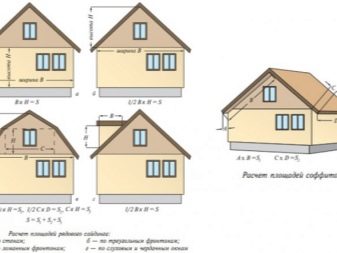

If the structure has an unusual or complex shape, then for simplicity of calculations it is divided into simple figures (square, rectangle).
Having learned the necessary parameters, you can start calculating the material. It is worth starting with a vapor barrier. Its amount is equal to the surface area of the walls. Plus, you need to add 20-30 cm from each edge to the overlap in the corners in order to achieve a uniform coating. The amount of insulation exactly matches the area. There is no need to leave allowances.
The main parameter in his choice will be the density coefficient and the thickness of one plate. Each region of Russia has its own climatic characteristics, so these values are very important. Where a humid continental climate dominates, craftsmen advise using a denser and thicker layer, but the ventilation gap should be small so that less moisture gets in. This is due to the fact that the mineral wool absorbs moisture and increases its weight, and accordingly increases the pressure on 1m² of the wall surface.
Do not forget about building fungi for fixing the insulation. Their number is taken at the rate of 5-6 pieces per 1 sheet.
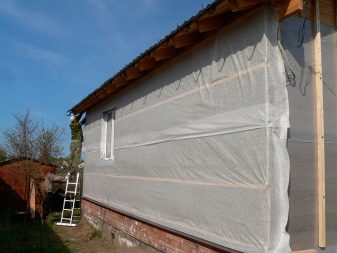
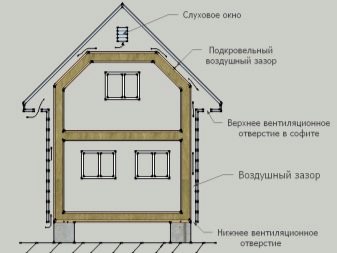
The cladding material is equal to the area of the walls, but it is worth adding a few slabs in case of scrap or trimming. The larger the building, the more stock should be (approximately 5-7% of the total). The calculation of the metal frame will be a little difficult. This is due to the fact that the frequency of intersections depends on the type and weight of the facade slabs or panels.
Masters recommend taking a frame with a margin: the stronger the material holds, the longer it will last.
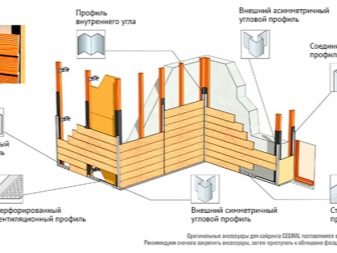
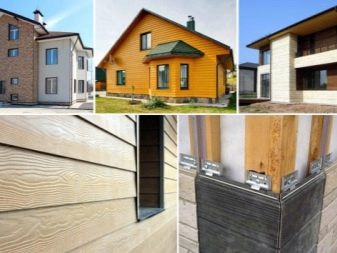
Installation methods
The ventilation facade installation technology is rather complicated. To do everything right with your own hands, you need to do all the work step by step and without haste. As the masters say, only within a year after installation will all the flaws and inaccuracies be revealed: the facade tile may fall off, a piece of insulation may fall out if it is poorly attached. All work is divided into several stages.
- Preparatory work. The first thing to do is to fence off the area with warning signs for the safety of others. This rule mainly applies to large buildings that are located in busy areas of the city. Next, an inspection of the walls is done. All flaws and the state of the supporting structures are revealed. It is necessary to dismantle all attachments that will interfere with further work. Garbage is removed, old plaster is scraped off. The surface is prepared for the installation of the substructure (metal or timber frame).
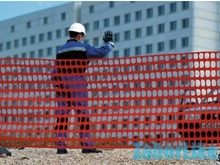

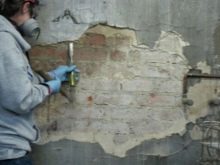
- Ruling the walls. At this stage, you will need a tape measure, laser and string. They will help to make the ruled without curvature and deviations. First of all, the lower horizontal line is indicated, which will be a guideline for setting the lowest level of the facing material. Further, with the help of a rope, vertical and horizontal axes are made at right angles with the same distance from each other.
In the places where they intersect, the so-called beacons are attached - these are future places for fastening clamps for wooden beams, dowels and brackets.


- Installing brackets that will hold the metal frame... For this, holes are made at the designated points using a perforator. It should be noted that the hammer drill is not suitable for all walls. If they are made of aerated concrete blocks or porous bricks, then here you need to use a drill with a special drill. Next, a dowel is driven in.
- Installation of a metal frame. It is fixed with self-tapping screws. Here, the so-called mesh is made, into which the mineral wool will be laid like a puzzle. At the same stage, fire cutoffs are mounted, which are necessary to block the free movement of air flows.They prevent fire from spreading along the outer perimeter of the building. It should be noted that the length of the hole should be a few millimeters longer. Then, with the help of anchors, the brackets are fixed.
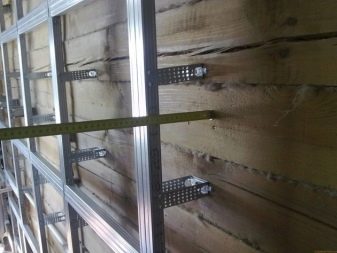
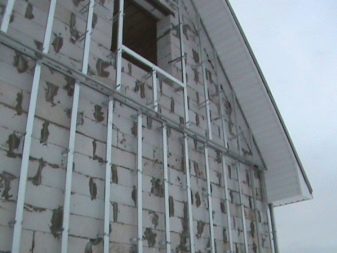
- Insulation laying... Before insulating the walls, they must be pre-treated with a special solution that prevents the appearance of mold and mildew. Insulation sheets are placed in the finished "grid" of the wall frame. They are fixed using dowels with a specific cap at the end so that the material does not slip or sag. A waterproofing film is laid on top.
It is very important that its edges overlap each other by at least 15 cm, otherwise the desired effect will not be achieved. Masters advise to start laying sheets of insulation from bottom to top in a horizontal direction. So, there will be fewer gaps and inconsistencies between the material.
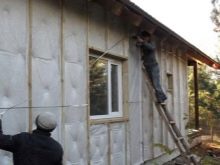
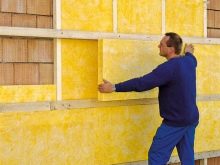
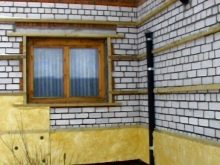
- Installation of facing slabs. First, the supporting rails are installed. On top of them, profiles are attached to which facade slabs or panels will be hung. The profile should be matched to the type of facade material, since each of them has its own special parameters: weight, thickness, and others. The cladding material is fixed with special rivets or self-tapping screws. It is necessary to maintain the same distance between the joints of the plates. For the strength of the structure, the square of tiles inside is fixed with an additional metal lock.
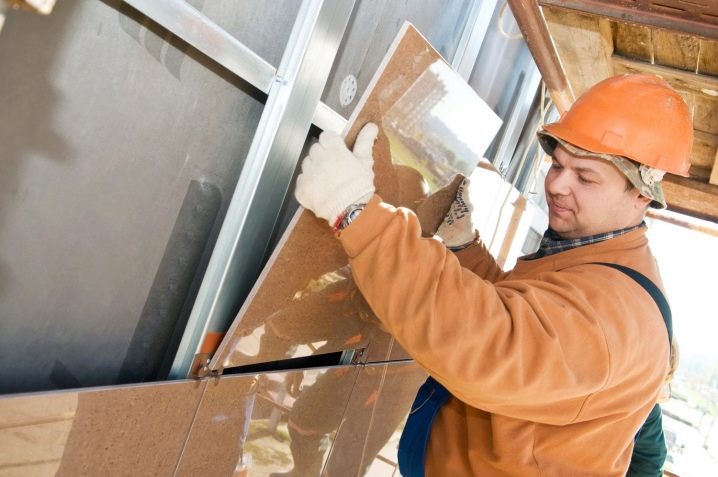
- Installation of slopes. After installing the facade, you can proceed to the window slopes and slopes on the loggia or balcony.

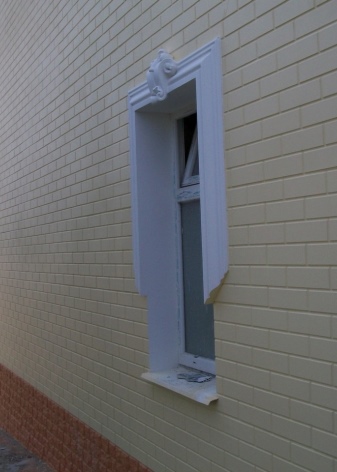
Beautiful examples
There are many possible design options for a ventilated facade. The main thing is that beauty is combined with functionality without compromising the construction. This image shows a vibrant color combination that refreshes the building and makes it more attractive.
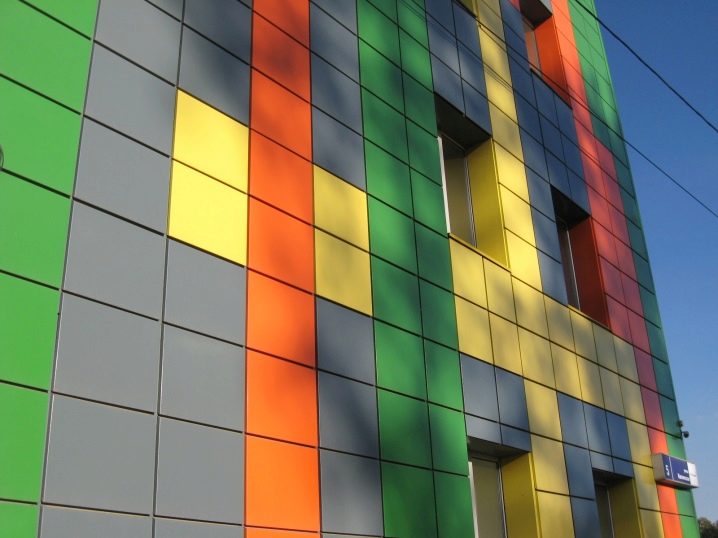
A private house can also be unusual and modern. Here there is a combination of two types of facing slabs: metal and porcelain stoneware. In the northern regions of the country, a ventilated facade is often made with two-layer insulation, which blocks the appearance of "cold bridges".
The presence of two layers does not affect the appearance of the building in any way.

Facade slabs can have completely different shapes and textures. This example shows a good combination of a hexagonal shape and a glass surface. The structure looks very impressive and unusual. Special attention should be paid to the non-standard design of the roof. The tiles were not laid clearly along the contour of the house, but made a little higher. Because of this, the entire building seems to be more airy and light.
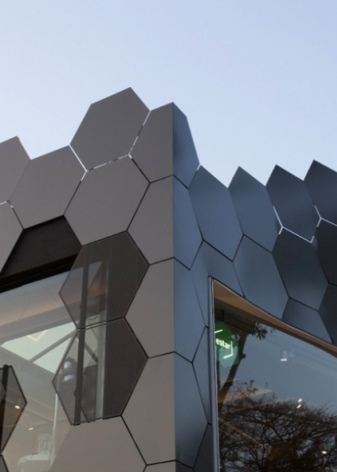
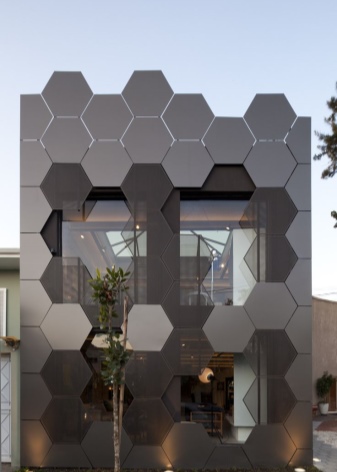
Such a building will forever be remembered by the residents of this city. Shown here is a successful combination of shapes, colors and textures. Round windows and rounded ornamentation on the ventilated facade create a futuristic look that you always want to look at.
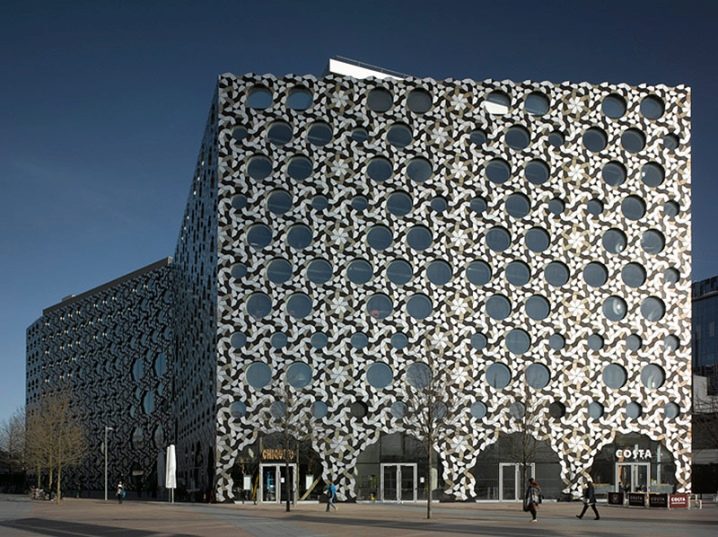
For the features of installation and marking of ventilated facades, see the following video.













The comment was sent successfully.